Lower extremity (leg, knee and ankle) injuries tend to occur over a wide range of unfortunate accidents. As a general rule, less impact is required for knee and ankle injuries which can result from a slip and fall or a less impactful motor vehicle accident. In contrast, the femur (thigh) – which is the longest, heaviest, and strongest bone in the human body – tends to sustain injury from more serious motor vehicle accidents involving greater force of impact.
In this article, we will take a look at six leg and ankle injuries and historical examples of the personal injury settlement values victims have received:
- Tibial Shaft Fracture
- Lateral Malleolus Fracture
- Bimalleolar Fracture
- Medial Malleolus Fracture
- Fracture of the Distal Fibula Along the Medical Cortex Above the Level of the Fibial Plateau
- Fracture of the Lateral Tibial Plateau
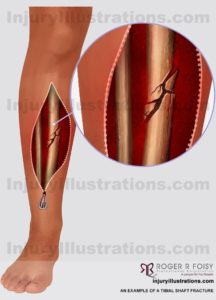 Tibial Shaft Fracture
Tibial Shaft Fracture
A fracture that occurs to the long bone that runs below the knee and above the ankle (tibia). Tibial shaft fractures are often caused by high-energy collisions, such as motor vehicle accidents and falling while playing sports such as skiing or soccer. Common symptoms include: pain, inability to walk or put weight on the leg, the bone protruding through a break in the skin, or a loss of feeling in the foot.
In 2012, the Court in Riehl v Hamilton (City), 2012 ONSC 3333 awarded the injured person $75,000 for injuries that included a tibial shaft fracture.
To read the full decision on CanLII, click here.
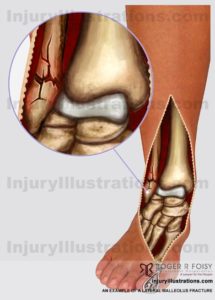 Lateral Malleolus Fracture
Lateral Malleolus Fracture
A fracture to the bone located to the outer aspect of the ankle. Lateral malleolus fractures are commonly caused by a roll of the ankle, an awkward landing from a jump, or a directly blow to the outer ankle. Common symptoms include: sharp outer ankle or lower leg pain, swelling, and bruising.
In 2002, the Court in Hutchison v Dalton, [2002] OJ No 4764 awarded the injured person $50,000 for injuries that included a lateral malleolus fracture.
To read the full decision on CanLII, click here.
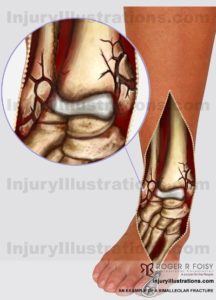 Bimalleolar Fracture
Bimalleolar Fracture
A bimalleolar fracture is the result of a fracture to the two lower bones that make up the ankle: one on the outside of the ankle and one on the inside. Bimalleolar fractures are often caused by motor vehicle accidents, falls, and twisting the ankle. Common symptoms include: swelling, tenderness, bruising, and inability to bear weight.
In 2011, the Court in Druet v Sandman Hotels, 2011 BCSC 232 awarded the injured person $55,000 for injuries that included a bimalleolar fracture.
To read the full decision on CanLII, click here.
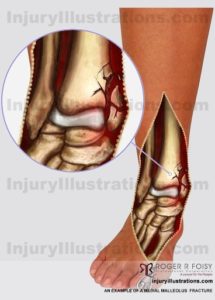 Medial Malleolus Fracture
Medial Malleolus Fracture
A medial malleolus fracture is the result of a break in the bony process located at the inner part of the ankle (medial malleolus). These fractures can be caused by a rolled ankle, an awkward landing from a jump, or a fall. Common symptoms include: sharp inner ankle pain, lower leg pain, swelling, and bruising.
In 2002, the Court in Hutchison v Dalton, [2002] OJ No 4764 awarded the injured person $50,000 for injuries that included a medial malleolus fracture.
To read the full decision on CanLII, click here.
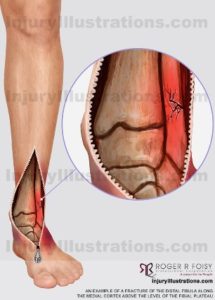 Fracture of the Distal Fibula Along the Medical Cortex Above the Level of the Fibial Plateau
Fracture of the Distal Fibula Along the Medical Cortex Above the Level of the Fibial Plateau
As one of the more common fractures at the ankle, distal fibula fractures are often the result of an inversion injury. Distal fibula fractures are often caused by trauma and the ankle twisting inward or outward. Common symptoms include: severe ankle pain, swelling, bruising, and an inability to bear weight.
In 2009, the Court in Rizzolo v Brett, 2009 BCSC 732 awarded the injured person $125,000 for injuries that included a fracture of a distal fibula.
To read the full decision on CanLII, click here.
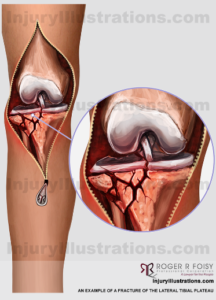 Fracture of the Lateral Tibial Plateau
Fracture of the Lateral Tibial Plateau
A tibial plateau fracture is the result of a break in the proximal part of the shinbone. Tibial plateau fractures can be caused by motor vehicle accidents, falls, or sports injuries. Common symptoms include: swelling, bruising, and an inability to bear weight.
In 2012, the Court in Riehl v Hamilton (City), 2012 ONSC 3333 awarded the injured person $75,000 for injuries that included a fracture of the lateral tibial plateau.
To read the full decision on CanLII, click here.
Receiving the Settlement You Deserve
People often believe that settlement value is mostly determined by the extent of the injury. While this is a factor, the most important information is how the injury has impacted your life. In other words, what does the injury prevent you from being able to do and how does this affect you?
I encourage you to view my previous article about seeking compensation for leg and knee injuries, wherein I discuss, in greater detail, the injury and how victims can receive the compensation they deserve.
A thorough lawyer should take the time to fully understand your specific situation, including your life and responsibilities before and after your accident, to ensure you do not under-settle your case. By quantifying every possible loss, you are more likely to receive a just settlement that will help to ease the financial burdens that usually occur during recovery.
If you have sustained a personal injury at another party’s fault, please contact me and my team of experienced personal injury lawyers for a free consultation.
*Roger R. Foisy is not a medical professional. The advice in this blog is not meant to be a substitute for medical advice.
Watch my video series about personal injury law.
More on Personal Injury from Roger R. Foisy:

